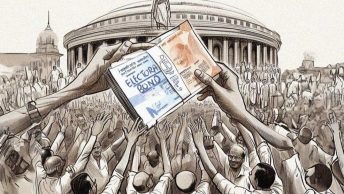[Our analyst Mrityunjoy Roy, writes about the Gauatam Navlakha case and Sudha Bharadwaj case in the context of including house arrest under the meaning of judicial custody under section 167 of Criminal Procedure Code, and its implications.]
Introduction:
Earlier this year, the Supreme Court of India (SC) in the landmark case of Gautam Navlakha v. NIA, read judicial custody under section (u/s) 167 CRPC to also include house arrest. The SC allowed Courts to remand accused persons to house arrest instead of jail in “appropriate cases”. Recently, the issue of house arrest and its computation for default bail has come up in the case of activist Sudha Bharadwaj. Similarly, appeals for grant of house arrest have been made to High Courts (HC) across the country.
This piece will try to explain the concept of house arrest and how the SC read it u/s.167 for computation of default bail and custody, and examine the larger implications of this development in criminal law.
Concept of House arrest and its use:
House arrest is a measure whereby a person is confined to their house by the Court or authorities, in lieu of prison or other custody. Historically it has been used as a method to silence political dissidents by authoritarian governments. For example, Burmese Activist Aung San Suu kyi in Myanmar was placed under house arrest after a military coup.
Its formal use for law enforcement has now become quite prevalent in many western nations. For instance, in the USA it is used primarily after trial for sentencing, where an accused as part of parole is sentenced to house arrest instead of jail, and is monitored through electronic tagging. The UK allows a limited form of house arrest with electronic tagging in the form of house curfews during certain times of the day as part of bail conditions. The degree of confinement varies, with home curfews on the one hand requiring confinement only during certain parts of the day, to home incarceration that require one to be confined to their house 24×7. Generally, exceptions to the house arrest exist in the form of emergency, essential shopping or any other allowance by the Court.
Many rationales are given for house arrest at different stages of trial. A common argument is that it reduces burden on overcrowded prisons, reserving that for the most egregious offenders. At the sentencing stage, it allows eligible offenders to retain or seek employment, maintain family relationships and responsibilities and attend rehabilitative programs, all of which can contribute to reduced recidivism. At the pre-trial stage, it has been justified as a less harsh form of custody where liberty is sufficiently restricted to allow investigation and check flight risk, while at the same time allowing the accused the relative comforts of home and family. With burgeoning prison populations, and the potential social benefits of house arrest, its use has been growing across the world.
How the Supreme Court read in House arrest:
In India, house arrest has only been seen in preventive detention laws, such as Section 5 of the National Security Act, 1980 which allows the government to preventively detain persons in any premises, including their house. The detention of various political leaders in J&K at present is an example is an example of such a use of house arrest. However, preventive detention does not come under the ambit of ‘custody’ under CRPC, and the CRPC or any other law also has no mention of house arrest.
After a person is arrested, s.167 of CRPC empowers a magistrate to “authorise the detention of the accused in such custody as such Magistrate thinks fit”. Earlier this year, the SC in Gautam Navlakha v. NIA (para 94) noted that s.167, except prohibiting police custody beyond the first 15 days, does not restrict the form of custody a magistrate can order. It is simply that custody has traditionally been understood as either police custody or custody in jail. The Court discussed this issue in light of overcrowding of prisons in India, and the plight of a high number of undertrial prisoners (para 49,50). It argued that given the situation, perhaps jail would best be reserved for the most dangerous criminals. Therefore, it held that in appropriate situations, Courts could remand accused u/s. 167 to house arrest instead of jail or police custody.
On the issue of calculation of house arrest for grant of default bail, the SC pointed out that the right to default bail is a fundamental right under Article 21, since it is inherently linked to a right to liberty. It explained that what is relevant under s.167 is ‘actual detention suffered’, and not its character. The Court held that house arrest was not a protection of liberty of an accused as argued by the government, but constituted detention due to the restrictions placed on freedoms. It differs only in degree from police or jail custody. Therefore, it held that if the house arrest is ordered by any court u/s. 167 then that is a form of judicial custody, and would be counted while computing the period for default bail (para 98).
It should be noted that what is critical here is that the house arrest should be ‘intended to be ordered u/s. 167 CRPC’. Therefore, custody ordered under any other special provision by any court would not be counted. Applying this principle to the facts at hand, the Supreme Court in Gautam Navlakha held that the period spent by Navlakha under house arrest would be excluded because the HC while sending him to house arrest did not intend for it to be counted for bail u/s.167, and because the investigating agency did not have access to him during the said period.
Recent instances of possible inclusion of House Arrest under Judicial Custody:
Sudha Bharadwaj v. NIA:
Sudha Bharadwaj was arrested by the National Investigation Agency (NIA) on 28th August, 2018 in relation with the Elgar Parishad case. Transit remand was granted by the chief judicial magistrate (CJM), Faridabad to take the accused to Maharashtra, but the same was stayed by the Punjab & Haryana HC on a habeas corpus petition being filed by Bharadwaj. The Punjab and Haryana HC ordered Bharadwaj to be kept under house arrest during the hearing of the petition. The SC by its order on 28th August, 2018 extended the house arrest. Thereafter, the HC dismissed Bharadwaj’s habeas corpus petition on 28th September, 2018, but extended the house arrest by 4 more weeks. Finally, Bharadwaj surrendered to the police on 27th October, 2018 after 60 days of house arrest upon dismissal of her bail application by the sessions court, who remanded her to police custody. On November 26, 2018, Bharadwaj filed an application for default bail under s.167 CRPC as no charge sheet had been filed by the police, after completion of 90 days from the date she was put under house arrest and 30 days after she was taken into police custody. She argued that the period of house arrest should be computed for computation of the 90 day period for default bail.
The Bombay HC in its order dated 1st December,2021 held that the Punjab & Haryana HC did not purport to order Bharadwaj’s house arrest u/s. 167, but rather under its inherent powers in criminal law. Therefore, it held that the period of house arrest would not be counted for her default bail. Bail was however granted on other grounds, since though the period of house arrest was not counted, the chargesheet was not filed until February, 2019, long after the 90 day period had expired since her police custody. Therefore, she was granted default bail nonetheless.
Narada case:
A proper use of house arrest may be seen in the Narada case earlier this year. In this case, 4 members from the Trinamool Congress were granted bail by the CBI special court after their arrest. The Calcutta HC stayed the bail order and sent the accused persons to house arrest. On a later date, a larger bench of the Calcutta HC enlarged the accused on interim bail u/s.439 CRPC.
In this case chargesheets had been filed, but had they not been filed then interim bail would’ve been granted u/s.167 CRPC. Since after house arrest the bail was granted through the formal provisions for bail, without considering the period of house arrest as void, the period probably would’ve been counted for default bail u/s.167 CRPC.
Some potential implications of the Gautam Navlakha v. NIA judgement:
The implications of the judgement are vast and many questions remain unanswered about how house arrest is to be given effect.
The judgement has been lauded by many for helping civil society activists and politicians being persecuted by the government, and others who undergo long periods of jail custody. Such custody, other things being equal, would certainly be more comfortable over prolonged periods and lessen harassment. The method may also be considered in light of the SC orders to decongest jails in the pandemic. As added protection the court could order some jail custody to be converted to house arrest instead of enlarging them on bail. This would perhaps also satisfy the government’s concerns of flight risk or tampering with investigation, making them agree to let out more people in this manner.
However, the SC did not give guidelines for when house arrest should be ordered. It only briefly gave non-exhaustive considerations “like age, health condition, antecedents of the accused, nature of the crime, the need for other forms of custody and enforceability of house arrest”, to determine its appropriateness. At present, pleas of Ex-police officer Sachin Vaze, and activist Gautam Navlakha are pending before the Bombay HC who seek to have their jail custody converted to house arrest citing medical grounds and the covid-19 pandemic. This has been resisted by the police who cite flight risk, and adequate medical facilities at the jail. The exact modalities of when house arrest would be justified would have to be worked out through future cases.
Some scholars have expressed concern about judges being more open to custody in every case after this verdict. In situations where though no case for regular custody is made out, judges may resort to house arrest seeing it as an acceptable “middle path” due to police opposition to bail and mere severity of the charge. This would result in deprivation of liberty where persons should have otherwise been let off, leading to increased harassment.
Appropriateness though would most probably depend on enforceability. India currently has no law or system for electronic tagging or monitoring of prisoners remotely, and even if there were, many questions about its appropriateness, and privacy concerns remain unanswered. Enforcing house arrest would then require policemen to be individually placed at every accused’s house, which would be expensive and difficult when employed on a wide scale. Effectiveness of such enforcement is also questionable, and if it’s not done then it is as good as letting people out on regular bail. Recently, the escape of two Korean nationals placed under house arrest by the SC has raised more concerns about the implementation of this measure. All of this would certainly weigh on a judge’s mind, making it difficult to confidently order house arrest, thereby perhaps discouraging them.
Conclusion:
Allowing house arrest as an alternative to jail or police custody is a landmark move, expanding our understanding of custody in Indian law. However, the idea is still too abstract and leaves a lot of questions and practicalities around the issue unanswered. Clearly the appropriateness of house arrest would turn to the facts of each case, but some detailed guidelines by the SC would’ve been helpful while allowing such a leap in the law to prevent its misuse. Unless some detailed guidelines are given and systems for enforcement including specific laws are put in place, house arrest risks becoming a development only on paper reserved for the privileged few, instead of genuine progress for criminal law.
Further readings:
To understand more about this issue, you could read further on:
- Gaurav Thote, Analysing the concept of ‘house arrest’ in criminal matters, Bar and Bench (May 30, 2021).
- V. Venkatesan, Navlakha Bail Denial Flawed But SC Backing House Arrest as Alternative to Jail a Blow for Rights, The Wire (May 13, 2021). This article argues that the SC’s judgement in Gautam Navlakha v. Union of India was flawed in how it computed the house arrest period for bail, but argues that looking at house arrest as a form of custody is a good start.
- Karan Tripathi, House Arrest, Not Jail as Custody, Says SC: A Good Idea, But…,The Quint (May 15, 2021). It argues that while reading house arrest as a form of custody is a good idea, the SC has created much ambiguity about its use and operationalisation. The article quotes Nikita Sonovane, who contends that it will be harmful for marginalized or poor communities since house arrest has the potential to act as a tool of perpetuating the surveillance and criminalisation of communities.
- Staff, SC Dismisses NIA Plea Against Default Bail for Sudha Bharadwa,The Wire (Jan, 2022). It explains the proceedings in the Sudha Bharadwaj case and gives the most recent update, wherein the SC dismissed NIA’s appeal against Bombay High Court order.
- Apoorva Vishwanath, No legal basis for Supreme Court’s house arrest order in Bhima-Koregaon case, The Print (Sept. 21, 2018). The article argues that the 2018 order of the SC remanding those accused in the Bhima Koregaon case to house arrest was without any legal basis
6. V. Venkatesan, Why Saifuddin Soz’s Failure to Secure Freedom from ‘House Arrest’ Should Concern Us All, The Wire (Aug 2, 2020). The article explains how courts generally evaluate house arrests when it is used by the state in the preventive detention context in India.
Mrityunjoy Roy is a third year student at NALSAR University of Law, and an associate analyst for LAOT. He is primarily interested in public policy and criminal law.







Allowing house arrest as an alternative to jail or police custody is a landmark move, expanding our understanding of custody in Indian law. However, the idea is still too abstract and leaves a lot of questions and practicalities around the issue unanswered. Clearly the appropriateness of house arrest would turn to the facts of each case, but some detailed guidelines by the SC would’ve been helpful while allowing such a leap in the law to prevent its misuse.
Your article helped me a lot, is there any more related content? Thanks!